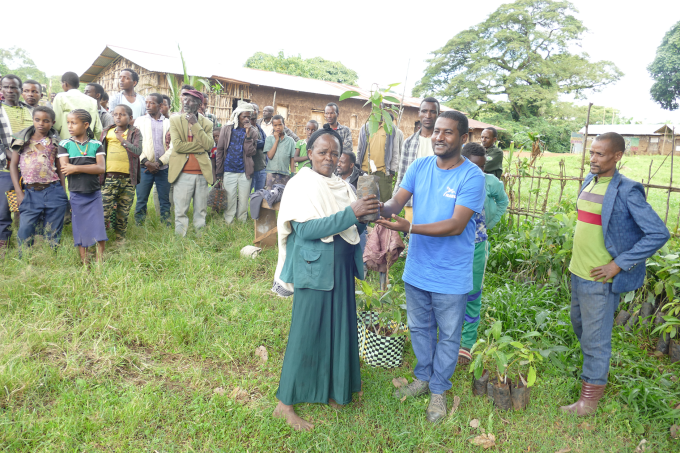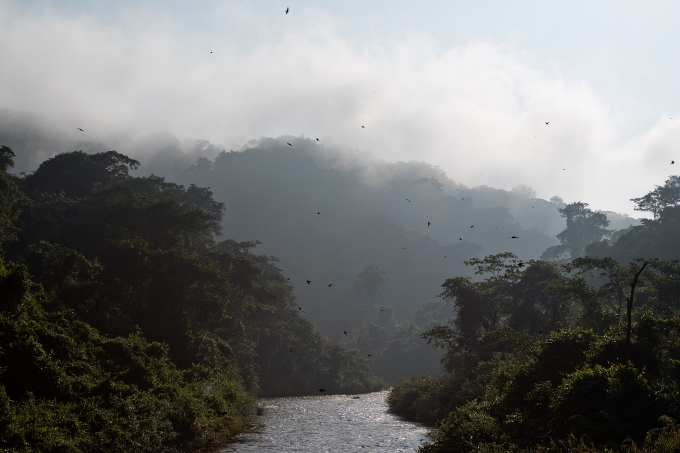ForestConnect
Forest landscapes for securing climate and ecosystem resilience
Southwest Ethiopia hosts the country's last continuous highland forest areas, ranging from the vast plateaus to the lowlands on the border with Sudan. These diverse forests, including rainforests, montane cloud forests, bamboo forests and dry forests, play an important role in carbon storage and are home to unique, specialised species such as mantled guerezas and crowned eagles. They also serve as important water sources and reservoirs for water catchment areas such as the Omo-Gibbe in Kenya, also known as Lake Turkana, and the Baro-Akobo, a tributary of the White Nile.
However, the increasing demand for resources due to social and economic growth has affected the region's forests through degradation and fragmentation. The climate crisis is exacerbating this effect. Higher temperatures have altered rainfall patterns, while the fragmentation of forests has made them more vulnerable to drought, fire and pest infestation. The degradation of forest landscapes threatens vital ecosystem services for humans, plants and animals: it jeopardises the habitats of many species, the function of forests to store carbon and water and the long-term food security of the local population, especially in rural areas.
Overcoming these interlinked challenges requires a comprehensive and cooperative approach that encompasses environmental protection, sustainable resource management and socio-economic development. As part of the predecessor project Forests for Future, the capacities of relevant stakeholders were strengthened and Forest Landscape Restoration Action Plans (FLRAPs) were developed. To implement the restoration and conservation of forest landscapes, NABU has launched the project ForestConnect in cooperation with NABU Ethiopia and Ethio Wetlands and Natural Resources Association (EWNRA) and with the support of the German Federal Ministry for Economic Cooperation and Development (BMZ).
-
With tree seedlings, local communities’ income sources are strengthened and forest landscapes get restored. – photo: NABU
-
Forest Landscape Restoration Action Plans not only facilitate forest conservation but also income-supporting measures like beekeeping. – photo: Maheder Haileselassie
-
The action plans were developed in a participatory approach involving relevant zonal stakeholders and community members. – photo: NABU
-
NABU, NABU Ethiopia and EWNRA work together on the restoration and conservation of Southwest Ethiopia’s pressured forest landscapes. – photo: Maheder Haileselassie
Project facts
Project title
IKU - ForestConnect: Forest landscapes for securing climate and ecosystem resilience
Country/Region
Southwest Ethiopia
Period
November 2023 to October 2026
Partners
see dropdown menu below
Sponsored by / Supported by
German Federal Ministry for Economic Cooperation and Development (BMZ)
The Nature and Biodiversity Conservation Union (NABU)
With this project we are contributing to the following SDGs:
2,6,11,12, 13,14, 15, 17
More details
Project goal and approach
Our goal is to initiate community-based forest restoration in the degraded and pressured target forest landscapes of Bench-Sheko, Kafa, and Sheka, diversify income opportunities for forest-dependent communities in a nature-friendly way, and expand and strengthen structures and awareness of effective forest landscape restoration methods (FLR) among key actors.
The planned activities include:
- management and Restoration of Forest Landscapes (FLR) through a participatory process, community-led implementation, nurseries, seedlings planting, and sustainable forest management.
- improving livelihoods for forest-dependent communities through nature-based income opportunities.
- institutionalisation, advocacy, and sustainable financing.
- communication, multiplication, capacity development.
The project aims to indirectly benefit about 3 million inhabitants in 21 districts, including smallholder farmers, especially women, youth, and underserved groups, as well as Participatory Forest Management groups, community members, governmental representatives, and local NGOs/CBOs.
Our project sites
The South West Ethiopia Peoples’ Region (SWEPR) region, which previously attracted little attention, has gained political importance at the national level. The project concentrates on the zones of Bench-Sheko, Kafa, and Sheka, building upon the groundwork laid in the previous initiative.
Bench-Sheko Zone is the region with the greatest lowland share and has suffered severe forest decline. Between 1986 and 2001, forest cover decreased from around 20% to only 12% (2,881 km²), especially in the regions where refugees from the arid regions of Ethiopia were settled. Studies prove the population's dependence on forest resources: income from forest resources is the most important source of livelihood for the population, alongside agriculture.
Kafa Zone, with the Kafa Biosphere Reserve, is characterised by species endemism in Afromontane Mountain cloud, rain, and bamboo forests and is a supra-regionally important water supplier. The forests and wetlands are under pressure from the effects of climate change and coffee/tea investors and are already highly fragmented. Unemployment and lack of prospects lead to frustration, political uprisings, and the search for income, especially among young people, e.g., through illegal logging.
Sheka Zone or Sheka Forest Biosphere Reserve comprises unique natural landscapes of about 240,000 ha, ranging from cool, humid highlands to hot lowlands. The characteristic Afromontane rainforest contains Coffea arabica in the undergrowth. In the past, large areas of forest were converted into industrial tea production. Nevertheless, both the local government and the local population are keen to preserve the forests, which are strongly linked to spiritual beliefs and traditions and provide an important basis for life.
Partners and actors
The project will be managed by NABU Ethiopia in collaboration with EWNRA. The following regional SWEPR institutions are partnering the project:
- Bureau of Finance and Economy Development (BoFED)
- Bureau of Agriculture (BoA)
- Bureau of Women, Children and Youths (BoWCY)
- Bureau of Forest, Environmental Protection and Climate Change (BoFEPCC)
The project is financially supported by the German Federal Ministry of Economic Cooperation and Development (BMZ) and The Nature and Biodiversity Conservation Union (NABU).
Previous project
Degradation of highland forest landscapes of South Ethiopia is a serious threat to livelihoods and biodiversity. NABU is engaged with the goal of preserving the forests of Bench-Sheko, Kafa & Sheka as carbon sinks and long-term ecosystem service suppliers. more →
MORE
Iko Esai in Nigeria, Africa, is home to precious tropical rainforest and extraordinary biodiversity, including gorillas, chimpanzees and forest elephants. In collaboration with local communities and partners, NABU protects the forest and secures livelihoods. more →
The protected area Mahavavy-Kinkony in Madagascar suffers from degradation of its coastal ecosystems. NABU and ASITY Madagascar joined forces supporting communities for restoring ecosystems, improving livelihoods and responding to the impacts of climate change. more →
Climate change and biodiversity loss are the most pressing challenges to humanity. Finally, people start to realize they are both sides of the same coin. NABU stands with science. We demand and support all efforts to reach a net-zero carbon economy globally. more →










